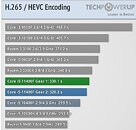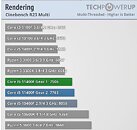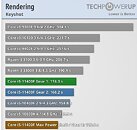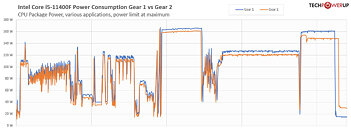Wednesday, April 7th 2021

Gear 1 can Lead to Performance Loss on Intel "Rocket Lake" 11th Gen Processors
In the course of our Core i5-11400F "Rocket Lake" processor review, we discovered that the Gear 2 memory mode has the potential to offer higher performance than Gear 1. The Gear 1 mode runs the memory frequency and memory controller frequency in 1:1 sync, while the Gear 2 mode runs them at 1:2, meaning that the memory controllers run at half the memory frequency, allowing you additional memory overclocking headroom. At lower, more stable, memory frequencies, it should be logical to use Gear 1. Our testing springs some surprising results.
Overall, a stock Core i5-11400F paired with DDR4-3733 MHz memory, was found to be 1.5% faster with Gear 2, when averaged across all our CPU tests, compared to Gear 1 at the same 3733 MHz frequency. Gear 2 was 3.42% faster in Cinebench R23 multi-threaded, and a staggering 6% in MySQL. Across rendering and media workloads that scale across all cores, we find Gear 2 faster by 1-3%. It's only with less parallelized workloads such as gaming, where we see Gear 2 lag behind Gear 1, though not by much. In our i5-11400F review, we show that by running your processor in Gear 2, you're making your memory controllers pull less power, freeing up power budget for the CPU cores, translating into the nT performance gains we see here. We discovered that the uncore can pull anywhere between 5 to 10 W more power in Gear 1 mode. This is valuable power eating into the already constrained power-budget of this 65 W TDP chip.
Read the Intel Core i5-11400F TechPowerUp ReviewThis behavior wasn't spotted in our launch-day i5-11600K and i9-11900K reviews; as the i5-11400F is our first Rocket Lake with a 65 W TDP. We expect the disparity between Gear 2 and Gear 1 at stock settings to only grow wider with higher core-count 65 W models, such as the Core i7-10700/F and the i9-11900/F. Gear 1 claws its way back to the top when you engage power limit overrides offered by motherboards. These overrides vary from motherboard to motherboard, but they generally free up more power budget for your CPU cores to sustain their boost frequencies better. For more data and commentary, be sure to catch our Core i5-11400F review.
Overall, a stock Core i5-11400F paired with DDR4-3733 MHz memory, was found to be 1.5% faster with Gear 2, when averaged across all our CPU tests, compared to Gear 1 at the same 3733 MHz frequency. Gear 2 was 3.42% faster in Cinebench R23 multi-threaded, and a staggering 6% in MySQL. Across rendering and media workloads that scale across all cores, we find Gear 2 faster by 1-3%. It's only with less parallelized workloads such as gaming, where we see Gear 2 lag behind Gear 1, though not by much. In our i5-11400F review, we show that by running your processor in Gear 2, you're making your memory controllers pull less power, freeing up power budget for the CPU cores, translating into the nT performance gains we see here. We discovered that the uncore can pull anywhere between 5 to 10 W more power in Gear 1 mode. This is valuable power eating into the already constrained power-budget of this 65 W TDP chip.
Read the Intel Core i5-11400F TechPowerUp ReviewThis behavior wasn't spotted in our launch-day i5-11600K and i9-11900K reviews; as the i5-11400F is our first Rocket Lake with a 65 W TDP. We expect the disparity between Gear 2 and Gear 1 at stock settings to only grow wider with higher core-count 65 W models, such as the Core i7-10700/F and the i9-11900/F. Gear 1 claws its way back to the top when you engage power limit overrides offered by motherboards. These overrides vary from motherboard to motherboard, but they generally free up more power budget for your CPU cores to sustain their boost frequencies better. For more data and commentary, be sure to catch our Core i5-11400F review.




43 Comments on Gear 1 can Lead to Performance Loss on Intel "Rocket Lake" 11th Gen Processors
Death by a thousand (power budget) cuts.
Because for example Gear2 3733Mhz 14-14-14-31-2T U need at least 4533 MHz cl20 Gear2 to be better (4266 c19 is similar)
As your article points out, what skews it is power draw, which is being constrained to keep within the rated specs. Once that constraint is lifted, the 1:1 ratio wins out, as expected. It makes sense that the higher performance mode would use more power.
Intel really needs that 10nm node badly so they won't have to use these power-limiting compromises quite so obviously.
You can probably get the same result on Ryzen by artificially running 1066MHz Infinity Fabric @ 0.9V VSOC where you save like 10W on SVI2 SOC power draw compared to 1866MHz 1:1 IF @ 1.1V VSOC. Like, yeah, you get 10W more to invest into the cores (if not already current, temp or voltage limited) and will probably get slightly better boost performance out of strict CPU benchmarks, but people don't build new 11th gen computers to run CPU benchmarks 24/7 at stock settings and nothing else.
In return, running Gear 2 or low IF speed both get you doodoo performance in 99% of everything else outside of CPU benchmarks, so is it really "performance loss"? It's not even a revelation that's useful to overclockers because 1) 11400F isn't winning any races regardless of what you do 2) power limit is not an issue on anything that isn't locked 3) power limit isn't even an issue on the 11400F as long as you remove them.
So basically, "Gear 1 can lead to performance loss" is about the same as saying "1900MHz+ IF can lead to performance loss". Both technically true to some extent, and both misleading and benefiting precisely nobody.
And now it seems what's supposed to be the best performance setting is the worst of the two gears.
14 nm really is on its last leg. Imagine if alder lake end up as 14nm as well.
Gear 2 is specifically for overclockers. Period. It's what allows the 11th gen IMC to outperform pretty much everything on the market except for *maybe* Renoir/Cezanne.
Do you think the average user will go into their BIOS to enable Gear 2 at mundane speeds just so they can gain 2% extra performance in rendering, while losing 4% fps in all their games? Read the review, there is literally no benefit to this whole running Gear 2 to get a tiny bit more boost shenanigans. It's exactly the same shit as intentionally crippling Infinity Fabric to gain a few extra MHz in CPU benchmarks.
And once the PL1 limit comes off, Gear 1 goes right back to being on top. The people that can understand what Gear 2 is, most likely aren't the kind of people leaving the stock PL1 limit in place.
I'm referring to the review summary on page 23 here: in Gear 2, you lose less than 2% in games, except at 720p. The total "performance per dollar" is higher by 1% for Gear2, with default power limits in place.
In web browsing, compiling, ML, compression, encryption, you mostly gain something between zero and ~4%. So it's a small margin either way.
The default for i5 and i7 chips is going to be Gear 2 anyway, and it looks sensible, at least for the 11400F.
So yes, Gear 2 is aimed at memory overclockers, but it can also bring a performance advantage wherever the power budget is tight (limited not by PL1 setting but by the actual cooling solution). Every watt saved by the MC counts - in Rocket's case, the difference between gears is an incredible 9W on idle, no overclocking involved! (And that's almost as much as a Haswell mini PC consumed on idle in 2014.)
This is why I believe we'll see two gears in Alder Lake as well - think about notebooks and their 15W - 45W power limits, which include the IGP.
I dunno if that's true about mobile - it's Superfin, better binned, and LPDDR4x seems to mitigate this problem. Perhaps the excessive Gear1 power consumption on RKL is more due to crappy backporting, 14nm, and the extremely tortured system agent. Also, some Z590 motherboards are defaulting to extreme levels of Auto VCCSA, didn't see anything in the review confirming that's not the case on the Hero.
Speaking of crappy backporting, even the midrange Coffee Lake chips could do ballpark 4000MT/s. Gear 2 did what was expected of it (raise the ceiling up significantly in the 5000-6000MT/s range), but wtf did they do to the IMC that the 1:1 limit in the 3000-4000 range is even lower than chips from 3 generations ago?
Intel is just being cheapskate with their silicon die size and decide to push higher voltage and less cores, kinda like AMD with the 6700XT. If the 11900K had 10cores working at lower freq/voltage, it's efficiency would look way better in paper.
Where Intel fucked up was for some reason undoing the Comet Lake die thinning/better STIM/thicker heatspreader. They literally erased last gen's thermal innovations that made it run relatively cool, and now it's back to the infernal 9900K package except this time it's even hotter. There's no way that stock AVX512 would be above 100C if Intel had pulled out all the stops like they did Comet Lake. derbauer already tested the delidded 11900K and iirc it was a double-digit temp difference. The whole thing just screams half-assed product.
Things are getting better and better.
First chart on this page, just with different values of course: www.techpowerup.com/review/intel-core-i9-10900k/18.html
Intel is so against the wall that they can't run the memclock at full speed when using fast memory, due to the ancient manufacturing process they are forced to use, the cores need every Watt they can get their hands on just to offer almost AMD like performance!
At this rate, I should look forward to next years Intel 6 core 14nm+++++++ flagship going against a Zen4 CPU, if AMD even bother to make a 6 core variant.
It's unfortunate that very few reviewers include idle power measurements - they are quite revealing. Apart from TPU, I only know of Hexus, and their numbers are similarly scary (i9-11900K on idle, which they only measured in Gear 1, vs. previous gen).
I can't comment on Intel's thing I couldn't know having not dabbled or read enough yet but doesn't seem like too much of a drama and to me could be more nuanced, what if you have 3200/3600 memory, IE lower speeds than 4000/ , perhaps there's a gain to be had with less core performance loss, I dunno.
After all most go for the sweet spot memory frequency not the ceiling.